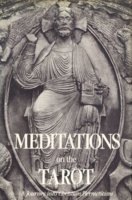Difference between revisions of "Meditations on the Tarot: A Journey into Christian Hermeticism"
m (Text replacement - "http://" to "https://") |
|||
| Line 1: | Line 1: | ||
[[Image:lighterstill.jpg]][[Image:Meditations_on_the_tarot-orig.jpg|right|frame]] | [[Image:lighterstill.jpg]][[Image:Meditations_on_the_tarot-orig.jpg|right|frame]] | ||
| − | '''Meditations on the Tarot: A Journey into Christian Hermeticism''' is a book published posthumuously and [[anonymous]]ly in 1985. It was originally written in French, and [[translated]] into [[English]] by Robert A. Powell of the [[ | + | '''Meditations on the Tarot: A Journey into Christian Hermeticism''' is a book published posthumuously and [[anonymous]]ly in 1985. It was originally written in French, and [[translated]] into [[English]] by Robert A. Powell of the [[https://www.sophiafoundation.org/ Sophia Foundation]. |
| − | Though the [[author]] published the book anonymously, since publication and his death, it has become well known that the [[writer]] was [ | + | Though the [[author]] published the book anonymously, since publication and his death, it has become well known that the [[writer]] was [https://en.wikipedia.org/wiki/Valentin_Tomberg Valentin Tomberg]. The Afterword states that "The author wished to remain anonymous in order to allow the work to speak for itself, to avoid the interposition of any kind of personal element between the work and the reader". |
| − | The author appears to be a [ | + | The author appears to be a [https://en.wikipedia.org/wiki/Roman_Catholicism Roman Catholic], although the ideas expressed are often not commonly associated with Catholic [[dogma]]. Many of the ideas are strongly influenced by [https://en.wikipedia.org/wiki/Carl_Jung Jungian] thought. The body of the work is divided into 22 Chapters, called "Letters", with a Foreword by the author and an Afterword by [https://en.wikipedia.org/wiki/Hans_Urs_von_Balthasar Hans Urs von Balthasar], a Swiss theologian. Each chapter is centered around a card from the [https://en.wikipedia.org/wiki/Major_Arcana Major Arcana] of the [https://en.wikipedia.org/wiki/Tarot_of_Marseilles Tarot of Marseilles]. |
Each card is taken as an "arcanum," which the author defines in part in '''Letter I: The Magician''' as "... that which it is necessary to 'know' in order to be fruitful in a given [[domain]] of [[spiritual]] life. ... a 'ferment' or an 'enzyme' whose [[presence]] stimulates the spiritual and the psychic life of man." He writes that they "are neither [[allegories]] nor [[secrets]] ... [but] authentic [[symbols]] ... [which] conceal and [[reveal]] their sense at one and the same time according to the depth of [[meditation]]." The symbolism of the cards is taken as a springboard for discussing and describing various aspects of [[spiritual]] life and [[growth]]. | Each card is taken as an "arcanum," which the author defines in part in '''Letter I: The Magician''' as "... that which it is necessary to 'know' in order to be fruitful in a given [[domain]] of [[spiritual]] life. ... a 'ferment' or an 'enzyme' whose [[presence]] stimulates the spiritual and the psychic life of man." He writes that they "are neither [[allegories]] nor [[secrets]] ... [but] authentic [[symbols]] ... [which] conceal and [[reveal]] their sense at one and the same time according to the depth of [[meditation]]." The symbolism of the cards is taken as a springboard for discussing and describing various aspects of [[spiritual]] life and [[growth]]. | ||
| Line 11: | Line 11: | ||
* ''Meditations on the Tarot: A Journey into Christian Hermeticism'' ISBN 1-58542-161-8. | * ''Meditations on the Tarot: A Journey into Christian Hermeticism'' ISBN 1-58542-161-8. | ||
==External links == | ==External links == | ||
| − | * [ | + | * [https://sophiafoundation.org/ The Sophia Foundation homepage] |
[[Category: Religion]] | [[Category: Religion]] | ||
[[Category: Philosophy]] | [[Category: Philosophy]] | ||
Latest revision as of 01:22, 13 December 2020
Meditations on the Tarot: A Journey into Christian Hermeticism is a book published posthumuously and anonymously in 1985. It was originally written in French, and translated into English by Robert A. Powell of the [Sophia Foundation.
Though the author published the book anonymously, since publication and his death, it has become well known that the writer was Valentin Tomberg. The Afterword states that "The author wished to remain anonymous in order to allow the work to speak for itself, to avoid the interposition of any kind of personal element between the work and the reader".
The author appears to be a Roman Catholic, although the ideas expressed are often not commonly associated with Catholic dogma. Many of the ideas are strongly influenced by Jungian thought. The body of the work is divided into 22 Chapters, called "Letters", with a Foreword by the author and an Afterword by Hans Urs von Balthasar, a Swiss theologian. Each chapter is centered around a card from the Major Arcana of the Tarot of Marseilles.
Each card is taken as an "arcanum," which the author defines in part in Letter I: The Magician as "... that which it is necessary to 'know' in order to be fruitful in a given domain of spiritual life. ... a 'ferment' or an 'enzyme' whose presence stimulates the spiritual and the psychic life of man." He writes that they "are neither allegories nor secrets ... [but] authentic symbols ... [which] conceal and reveal their sense at one and the same time according to the depth of meditation." The symbolism of the cards is taken as a springboard for discussing and describing various aspects of spiritual life and growth.
References
- Meditations on the Tarot: A Journey into Christian Hermeticism ISBN 1-58542-161-8.
